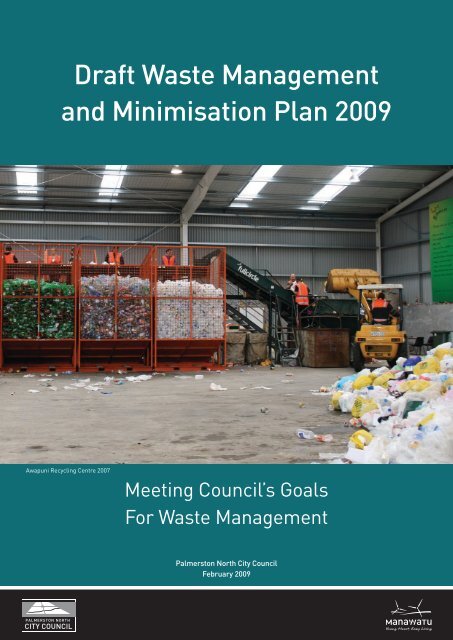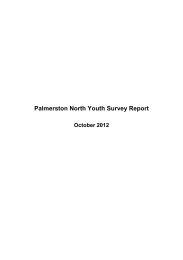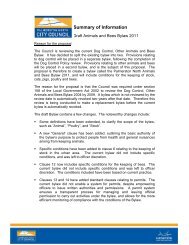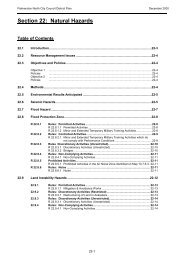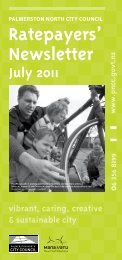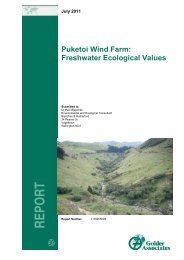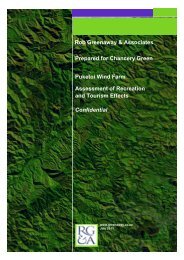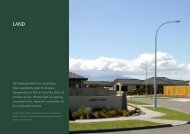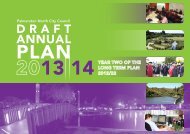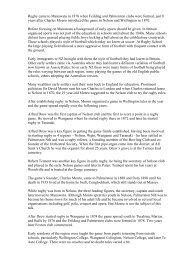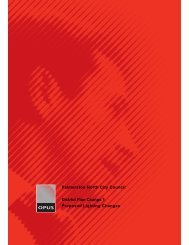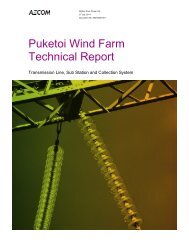Draft Waste Minimisation Plan - Palmerston North City Council
Draft Waste Minimisation Plan - Palmerston North City Council
Draft Waste Minimisation Plan - Palmerston North City Council
You also want an ePaper? Increase the reach of your titles
YUMPU automatically turns print PDFs into web optimized ePapers that Google loves.
<strong>Draft</strong> <strong>Waste</strong> Management<br />
and <strong>Minimisation</strong> <strong>Plan</strong> 2009<br />
Awapuni Recycling Centre 2007<br />
Meeting <strong>Council</strong>’s Goals<br />
For <strong>Waste</strong> Management<br />
<strong>Palmerston</strong> <strong>North</strong> <strong>City</strong> <strong>Council</strong><br />
February 2009
Contents<br />
Summary 1<br />
Introduction 1<br />
Vision 2<br />
Guiding Principles 2<br />
Target 2<br />
Legislative and Policy Framework 3<br />
How this <strong>Plan</strong> fits Together 4<br />
The <strong>Waste</strong> Management and <strong>Minimisation</strong> <strong>Plan</strong> 5<br />
Basic <strong>Waste</strong> Assessment 6<br />
A Way Forward 8<br />
<strong>Plan</strong> Review 9<br />
What We Will Do 10<br />
Financial Summary 15<br />
How to make a Submission 16<br />
<strong>Waste</strong> Management and <strong>Minimisation</strong> <strong>Plan</strong> 2009 - DRAFT
Summary<br />
The <strong>Council</strong>’s <strong>Waste</strong> <strong>Minimisation</strong> <strong>Plan</strong>, adopted in December 2005, is being revised to reflect changing<br />
perspectives about waste, both nationally and locally, since that time.<br />
Specifically, these changes are;<br />
• A desire for better service delivery, particularly for recycling systems;<br />
• A clear definition of what the <strong>Palmerston</strong> <strong>North</strong> <strong>City</strong> <strong>Council</strong> will deliver in terms of waste minimisation and<br />
waste management, including costs;<br />
• A clear response to the requirements of the <strong>Waste</strong> <strong>Minimisation</strong> Act 2008, including a greater commitment<br />
to the reduction of waste.<br />
Therefore this plan includes;<br />
• A vision that adopts the aim of the New Zealand <strong>Waste</strong> Strategy<br />
• A series of guiding principles to assist with decision making.<br />
• A basic waste assessment, and<br />
• A series of strategies to achieve the vision.<br />
Key elements of this <strong>Plan</strong> are;<br />
• A continuing move towards diversion of wastes from landfills and cleanfills<br />
• Recognition of the private sector in generating and handling wastes<br />
• Defining a leadership role for the <strong>Palmerston</strong> <strong>North</strong> <strong>City</strong> <strong>Council</strong> to work effectively with both our<br />
neighbouring <strong>Council</strong>s and the private sector.<br />
Introduction<br />
A key part of <strong>Palmerston</strong> <strong>North</strong> becoming a leading city in the quest for environmental sustainability is to<br />
change our approach to waste, by avoiding producing waste and to minimise the amount placed in landfills.<br />
It is anticipated that the cost of burying waste will increase over coming years as a result of landfills closing<br />
down, higher transport prices as fuel costs rise and as the waste levy, which must be paid on waste disposed<br />
of in landfills, increases.<br />
In addition, since the <strong>Council</strong>’s current <strong>Waste</strong> Management and <strong>Minimisation</strong> <strong>Plan</strong> was adopted in December<br />
2005, the <strong>Waste</strong> <strong>Minimisation</strong> Act (2008) has come into force that requires the <strong>Council</strong> to review its plan.<br />
For these reasons the <strong>Council</strong> established a <strong>Waste</strong> <strong>Minimisation</strong> Taskforce 1 comprising councillors, council<br />
officers, community and industry representatives to undertake a review and prepare this consultation<br />
document.<br />
Now we want to hear what you think about it.<br />
Submissions are sought on the framework and strategies outlined in this document. Details on how to make<br />
your views known to <strong>Council</strong> are included at the end of this document.<br />
<strong>Council</strong>lors will consider your views about this <strong>Plan</strong>, changing it where appropriate, before adopting it in<br />
August 2009.<br />
1<br />
The Taskforce comprised of Crs John Hornblow (Chair) and Chris Teo-Sherrell, Jonathon Hannon, Terry Kelly, David Forrest, David<br />
Bridges and council staff members Ray Swadel and Chris Pepper. The Taskforce met from August 2008 until March 2009.<br />
<strong>Waste</strong> <strong>Minimisation</strong> <strong>Plan</strong> 2009 - DRAFT 1
Vision<br />
Effective progress towards zero waste and a<br />
sustainable <strong>Palmerston</strong> <strong>North</strong><br />
Guiding Principles<br />
The following principles were identified by the Taskforce to help it develop this <strong>Draft</strong> plan.<br />
1.<br />
2.<br />
3.<br />
4.<br />
5.<br />
6.<br />
7.<br />
8.<br />
9.<br />
Act in the long term interests of the community<br />
Exercise leadership to achieve our vision, recognising our own strengths and weaknesses and the<br />
opportunities and threats that exist<br />
Collaborate with all those who want to work in the best interests of the community<br />
Move up the ‘‘6R waste hierarchy’’ as far as is possible<br />
Continue with the principle “polluters pay”<br />
Develop a strategic staged approach to waste minimisation<br />
Communicate in ways so that the strategies, aims, objectives and actions are transparent,<br />
understood and foster acceptance by the community<br />
Favour local utilisation of materials to support the local economy<br />
Implement systems that are:<br />
a. User friendly<br />
b. Affordable<br />
c. Cost effective<br />
d. Fair<br />
e. Resilient<br />
f. Achieve environmental excellence<br />
g. Have measurable performance indicators<br />
Target<br />
The Taskforce recommends adopting the following measureable target to help us achieve our vision.<br />
By 2015, <strong>Palmerston</strong> <strong>North</strong> will divert 75% of the<br />
waste that we currently bury in landfills and cleanfills<br />
to beneficial uses of waste.<br />
This is something other leading councils in New Zealand have already achieved or are very close to achieving.<br />
<strong>Waste</strong> <strong>Minimisation</strong> <strong>Plan</strong> 2009 - DRAFT 2
Legislative & Policy Framework<br />
The <strong>Council</strong> must make decisions on the plan in accordance with the following Acts of Parliament and<br />
Government policy statements.<br />
1.<br />
2.<br />
3.<br />
4.<br />
Local Government Act 2002<br />
Sets out the role and statutory obligations of <strong>Council</strong> in relation to community engagement which<br />
are pertinent to this plan.<br />
Health Act 1956<br />
Sets out requirements with regard to public health in New Zealand including hygienic disposal of<br />
waste.<br />
<strong>Waste</strong> <strong>Minimisation</strong> Act 2008<br />
New legislation with regard to waste management with specific requirements for <strong>Council</strong>s in New<br />
Zealand to have up to date waste plans.<br />
New Zealand <strong>Waste</strong> Strategy 2002<br />
Sets out the New Zealand Government preferred outcomes for waste minimisation, in particular the<br />
prevention of waste production and access to waste minimisation facilities and services.<br />
The <strong>Waste</strong> <strong>Minimisation</strong> Act 2008<br />
The purpose of this Act is to encourage waste minimisation and decrease waste disposal in order to:<br />
a.<br />
b.<br />
Protect the environment from harm; and<br />
Provide environmental, social, economic, and cultural benefits.<br />
The Act contains seven parts; the most relevant parts to the <strong>Palmerston</strong> <strong>North</strong> community are:<br />
Part 2 Product stewardship.<br />
The purpose of this part is to encourage (and, in certain circumstances, require) the people and<br />
organisations involved in the life of a product to share responsibility for:<br />
• Ensuring there is effective reduction, reuse, recycling, or recovery of the product<br />
• Managing any environmental harm arising from the product when it becomes waste<br />
Part 3<br />
Part 4<br />
<strong>Waste</strong> disposal levy.<br />
The purpose of this part is to enable a levy to be imposed on waste disposed of in landfills in order to<br />
raise revenue for promoting and achieving waste minimisation.<br />
It is anticipated that PNCC will receive a sum of approximately $280,000 per annum to fund waste<br />
minimisation activities. These waste minimisation activities are identified in the <strong>Draft</strong> 2009/19<br />
10 Year <strong>Plan</strong>.<br />
Responsibilities of territorial authorities in relation to waste management and minimisation.<br />
These responsibilities include:<br />
• Having a regularly updated <strong>Waste</strong> Management and <strong>Waste</strong> Management and <strong>Minimisation</strong> <strong>Plan</strong><br />
• Carrying out waste assessments<br />
• Powers to regulate waste practices through bylaws.<br />
The other parts of the Act are: Part 1 Preliminary provisions, Part 5 Offences and enforcement, Part 6<br />
Reporting and audits, and Part 7 <strong>Waste</strong> Advisory Board.<br />
<strong>Waste</strong> <strong>Minimisation</strong> <strong>Plan</strong> 2009 - DRAFT 3
How This <strong>Plan</strong> Fits Together<br />
VISION<br />
Give Effect To The Vision<br />
* Strategies 1,2 & 3 * Setting Priorities<br />
* Testing Strategic direction against guiding principles<br />
Implementation<br />
* Aims * Objectives * Actions<br />
Means of Implementation & Funding<br />
* Strategy 4<br />
<strong>Council</strong>’s 10<br />
Year <strong>Plan</strong><br />
& Annual <strong>Plan</strong><br />
Neighbouring<br />
<strong>Council</strong> & Private<br />
Sector Arrangements<br />
Community<br />
Initiatives &<br />
Programmes<br />
<strong>Waste</strong> <strong>Minimisation</strong> <strong>Plan</strong> 2009 - DRAFT 4
The <strong>Waste</strong> Management and<br />
<strong>Minimisation</strong> <strong>Plan</strong><br />
The private sector collects and disposes of approximately 80% of the <strong>City</strong>’s waste. This includes some recycling<br />
and the operation of landfills. The private sector currently operates two transfer stations which are located at<br />
Matthews Avenue and Malden Street, as well as providing various waste collection and disposal services.<br />
<strong>Council</strong> provides a weekly kerbside recycling and rubbish bag collection service primarily aimed at residential<br />
areas. <strong>Council</strong> also operates two recycling centres at the Awapuni Sustainable Development Centre and<br />
Ferguson Street, plus a transfer station at Ashhurst. Recycling and greenwaste are processed by <strong>Council</strong> at<br />
the Awapuni Sustainable Development Centre.<br />
Figure 1. 6R <strong>Waste</strong> Hierarchy<br />
re-think<br />
reduction<br />
re-use<br />
recycling<br />
recovery<br />
residue<br />
disposal<br />
(including<br />
energy recovery)<br />
Given that <strong>Council</strong> controls only a small percentage<br />
of <strong>Palmerston</strong> <strong>North</strong>’s waste, it seeks to work<br />
collaboratively with other waste operators to divert<br />
waste from landfill.<br />
The <strong>Council</strong> also provides ancillary support by way<br />
of environmental education, membership of the Zero<br />
<strong>Waste</strong> Academy, membership of national bodies,<br />
and financial support to community based waste<br />
minimisation activities.<br />
This <strong>Plan</strong> promotes behaviours and activities which<br />
reduce the need to dispose of waste by placing citizens<br />
as high as possible up the “6R <strong>Waste</strong> Hierarchy”.<br />
<strong>Council</strong>’s immediate focus, if agreed, will be to provide<br />
an improved recycling collection system, provide<br />
facilities to process recyclables, and provide economic<br />
green and organic waste facilities.<br />
Provision will be made in the 10 Year <strong>Plan</strong> and<br />
subsequent Annual <strong>Plan</strong>s to progressively implement<br />
this <strong>Waste</strong> Management and <strong>Minimisation</strong> <strong>Plan</strong>,<br />
and progress will be monitored through the Annual<br />
Report process.<br />
Figure 2. Where Our <strong>Waste</strong> Used To Go<br />
Awapuni landfill tip face C.2003<br />
<strong>Waste</strong> <strong>Minimisation</strong> <strong>Plan</strong> 2009 - DRAFT 5
Basic <strong>Waste</strong> Assessment<br />
A waste assessment is an estimate of the volume, make-up and flows of waste generated within each <strong>Council</strong><br />
boundary. The waste assessment described in this <strong>Plan</strong> is based on the final year of operation of the Awapuni<br />
landfill (February 2006 to January 2007), during which period practically all waste, excluding rubble and<br />
concrete, generated in <strong>Palmerston</strong> <strong>North</strong> was deposited at the <strong>Council</strong> owned and operated Awapuni landfill,<br />
which closed on 31January 2007.<br />
Figure 3. What’s In <strong>Palmerston</strong> <strong>North</strong>’s <strong>Waste</strong><br />
Nappies & Sanitaries<br />
Textiles<br />
Glass 4%<br />
4%<br />
Non Ferrous Metals<br />
4%<br />
Ferrous Metals<br />
5%<br />
Plastics<br />
10%<br />
2%<br />
Other<br />
1%<br />
Rubble/Concrete<br />
12%<br />
Timber<br />
6%<br />
Rubber<br />
1%<br />
Hazardous<br />
6%<br />
This composition and volume of waste<br />
generated in <strong>Palmerston</strong> <strong>North</strong> is expected<br />
to remain reasonably stable over the next<br />
few years as factors generating the waste<br />
such as industry and commercial sector<br />
structure, population and economic growth<br />
are not expected to change greatly.<br />
‘What’s in <strong>Palmerston</strong> <strong>North</strong>’s <strong>Waste</strong>’ shows<br />
that a large percentage of the current waste<br />
stream is able to be diverted from landfill.<br />
The taskforce has recommended that the<br />
<strong>Council</strong> focus first on the major fractions<br />
of the waste stream – recyclable material,<br />
organic wastes, and material currently<br />
being placed in cleanfills.<br />
Paper<br />
14%<br />
Non Garden Putrescibles<br />
5%<br />
Garden <strong>Waste</strong><br />
27%<br />
3<br />
This is based on approximately 45,000 trips to the landfill and a solid waste analysis<br />
undertaken in the final year of operation. Tonnes of waste received from outside<br />
<strong>Palmerston</strong> <strong>North</strong> were deducted. The composition has been adjusted for rubble and<br />
concrete as these wastes were not placed in Awapuni. An estimate was made on the<br />
basis from landfills in other areas.<br />
<strong>Waste</strong> Category<br />
What’s in <strong>Palmerston</strong> <strong>North</strong>’s <strong>Waste</strong><br />
Tonnage<br />
NZ <strong>Waste</strong><br />
Strategy %<br />
Reduction<br />
Rubble/Concrete 13100 50<br />
Timber 6753 50<br />
Rubber 1161<br />
Hazardous 6666 20<br />
Garden <strong>Waste</strong> 29617 60<br />
Non Garden Putrescibles 5623<br />
Paper 15652<br />
Plastics 11065<br />
Ferrous Metals 5346<br />
Non-Ferrous Metals 3403<br />
Glass 4213<br />
Textiles 3969<br />
Nappies & Sanitaries 2017<br />
Other 588<br />
TOTAL 109172<br />
<strong>Draft</strong> <strong>Waste</strong> Management and <strong>Minimisation</strong> <strong>Plan</strong> Target 75<br />
<strong>Waste</strong> <strong>Minimisation</strong> <strong>Plan</strong> 2009 - DRAFT 6
Figure 4. Who Controls Our <strong>Waste</strong><br />
PNCC<br />
16%<br />
Figure 4. ‘ Who Controls Our <strong>Waste</strong>’ shows that the<br />
<strong>Palmerston</strong> <strong>North</strong> <strong>City</strong> <strong>Council</strong> doesn’t control all of<br />
the waste.<br />
In order to achieve the vision of this <strong>Draft</strong> <strong>Waste</strong><br />
Management and <strong>Minimisation</strong> <strong>Plan</strong> it is important<br />
that <strong>Council</strong> work collaboratively with other waste<br />
operators to ensure that a larger proportion of<br />
<strong>Palmerston</strong> <strong>North</strong>’s waste is diverted from landfill.<br />
Private<br />
Commercial<br />
84%<br />
Who Controls Our <strong>Waste</strong><br />
<strong>Waste</strong> Source Tonnage %<br />
PNCC<br />
Greenwaste Drop Off 3839 4<br />
Operations <strong>Waste</strong> 1724 2<br />
Kerbside Rubbish Collection 7592 7<br />
Recycling Collection 3820 3<br />
PNCC TOTAL 16975 16<br />
Private Sector<br />
Commercial <strong>Waste</strong> Collection 72344 66<br />
Cleanfill (estimate) 19853 18<br />
Private Sector TOTAL 92197 84<br />
CITY TOTAL 109172 100<br />
<strong>Waste</strong> <strong>Minimisation</strong> <strong>Plan</strong> 2009 - DRAFT 7
A Way Forward<br />
Four strategies have been identified.<br />
Strategy 1 Strategy 2 Strategy 3<br />
Reduction and Diversion<br />
of <strong>Waste</strong> (incl Rethink, Reuse,<br />
Reduce, Recycle)<br />
• Reduction, Reuse<br />
and Recycling<br />
• Programme Types:<br />
• Dry recyclable material<br />
• Organics<br />
• Construction and<br />
demolition<br />
• Hazardous and Special<br />
• Other wastes (nappies,<br />
textiles, rubber etc)<br />
• Resource Recovery Park<br />
• Education / Promotion<br />
Collection of Residual <strong>Waste</strong><br />
• Domestic<br />
• Commercial and Industrial<br />
• Public Space<br />
Disposal of Residual <strong>Waste</strong><br />
• General <strong>Waste</strong><br />
• Construction and<br />
demolition waste<br />
• Cleanfill<br />
• Hazardous <strong>Waste</strong><br />
Strategy 4<br />
Means of Implementation and Funding<br />
• Disposer Pays<br />
• Use of <strong>Waste</strong> Levy Funds<br />
• Regulatory Tools<br />
• Obtain economies of scale by working with neighbouring <strong>Council</strong>s and Private Sector waste<br />
management companies and efficiencies<br />
• Providing Leadership<br />
Details on how these strategies will be implemented are contained in the section ‘What will we do’ on<br />
page 10.<br />
<strong>Waste</strong> <strong>Minimisation</strong> <strong>Plan</strong> 2009 - DRAFT 8
36% Of Current <strong>Waste</strong> Stream<br />
Proposed Enhanced Recycling Service<br />
Figure 5. A Way Forward<br />
Non Ferrous<br />
Plastics<br />
Paper<br />
Glass<br />
Ferrous Metals<br />
Garden Organic<br />
Textiles<br />
Nappies &<br />
Sanataries<br />
Other<br />
Timber<br />
Rubble/Concrete<br />
Rubber<br />
Non-Garden<br />
Organic<br />
Potential for further diversion from landf ill<br />
Hazardous<br />
32% Of Current <strong>Waste</strong> Stream<br />
Figure 5<br />
‘ A Way Forward’ shows how the<br />
segments of the waste stream will be<br />
addressed by this <strong>Draft</strong> plan.<br />
32% Of Current <strong>Waste</strong> Stream<br />
Proposed Or<br />
g<br />
a<br />
n<br />
ic <strong>Waste</strong> Utilisation<br />
Facility Service Improvements<br />
<strong>Plan</strong> Review<br />
The objectives of this <strong>Plan</strong> will be reviewed on a six year cycle, and the Key Performance Indicators on a three<br />
year cycle, to maintain the currency of the plan.<br />
It is intended to undertake a more detailed waste assessment and produce a more complete plan that meets<br />
the full requirements of the <strong>Waste</strong> <strong>Minimisation</strong> Act by December 2012.<br />
<strong>Waste</strong> <strong>Minimisation</strong> <strong>Plan</strong> 2009 - DRAFT 9
<strong>Draft</strong> 10 Year <strong>Plan</strong> Provision<br />
Currently no provision.<br />
Present for next review of<br />
10 Year <strong>Plan</strong> (2012/22).<br />
Currently no provision.<br />
Present for next review of<br />
10 Year <strong>Plan</strong> (2012/22).<br />
What Will We Do<br />
Strategy 1: Reduction and Diversion Of <strong>Waste</strong><br />
Aim 1.1 Reduction, re-use, and recycling<br />
To provide services and funding that encourage the avoidance of waste and its disposal in landfills<br />
Objectives Actions<br />
Recommended<br />
Timeframe<br />
1.1.1 Obtain detailed information about the sources /<br />
quantities and flows of different types of waste in order<br />
to develop an accurate basis for on-going measures to<br />
reduce the volume of waste disposed of.<br />
1.1.1 (a) Undertake a detailed survey of waste streams<br />
in order to develop an accurate basis and strategy for<br />
reducing the volume of waste disposed of to landfills<br />
1.1.1 (b) Investigation and assessment into how further<br />
amounts of waste could be diverted from landfill<br />
(prioritising green, organic and cleanfill wastes)<br />
<strong>Waste</strong> <strong>Minimisation</strong> <strong>Plan</strong> 2009 - DRAFT What Will We Do 10<br />
1.1.1 (c) Continue to support the research and<br />
development with Massey and other partners of best<br />
practices that support waste diversion.<br />
1.1.2 To obtain additional funding for initiating new<br />
actions to reduce waste to landfills 1.1.2 (a) Provide wheelie bins for kerbside recycling to<br />
all residential properties in the <strong>City</strong>.<br />
1.1.3 To identify opportunities at a regional level for<br />
increased efficiencies in how waste is reduced or diverted<br />
from disposal to landfills.<br />
1.1.2 (b) Develop and improve facilities for the<br />
processing of organic wastes (including sewage sludge)<br />
1.1.2 (c) Develop and refine waste reduction and<br />
diversion programmes in the following categories:<br />
• Dry recyclables<br />
• Construction and Demolition<br />
• Organics<br />
• Hazardous and Special <strong>Waste</strong>s<br />
• Cleanfill<br />
On-going<br />
December<br />
2010<br />
July 2013<br />
Programme 374 ‘‘<strong>Waste</strong><br />
<strong>Minimisation</strong> - Funding to assist<br />
Activities.’’ $152K 2009/10 &<br />
on-going for the period end<br />
of the 10 Year <strong>Plan</strong><br />
Programme 18 ‘‘<strong>Waste</strong><br />
<strong>Minimisation</strong> - Introduction of<br />
Recycling Wheelie Bins.’’<br />
$6M 2009/10 & 2010/11<br />
Programme 16 ‘‘<strong>Waste</strong><br />
<strong>Minimisation</strong> - Organic <strong>Waste</strong><br />
Collection and/or Treatment<br />
Service.’’ $3M 2010/11<br />
Currently no provision.<br />
Present for next review of<br />
10 Year <strong>Plan</strong> (2012/22).<br />
1.1.3 (a) Consider as part of detailed waste assessment. Currently no provision.<br />
Present for next review of<br />
10 Year <strong>Plan</strong> (2012/22).
To develop a facility (or facilities) to recover and re-use materials from the waste stream which encourage commercial and community<br />
involvement in waste reduction activities.<br />
<strong>Draft</strong> 10 Year <strong>Plan</strong> Provision<br />
*1<br />
Programme 17 ‘‘<strong>Waste</strong> <strong>Minimisation</strong> - Community to assist diverting waste away from Landfill,’’ considered but not included in <strong>Draft</strong> 10 Year <strong>Plan</strong><br />
*2<br />
Programme 374 ‘‘<strong>Waste</strong> <strong>Minimisation</strong> - Funding to assist Activities.’’ $152K 2009/10 & on-going for the period end of the 10 Year <strong>Plan</strong><br />
Strategy 1: Reduction and Diversion Of <strong>Waste</strong><br />
Aim 1.2 Resource recovery park<br />
Objectives Actions<br />
Recommended<br />
Timeframe<br />
1.2.1 To investigate and determine an optimum location<br />
for a resource recovery park and/or facilities.<br />
NOTE: Representatives from Green Hub & <strong>Waste</strong> Plaza<br />
Group have indicated they propose to present a separate<br />
business case Submission to <strong>Council</strong> by April 2009.<br />
1.2.1 (a) To develop a business plan for a sustainable<br />
resource recovery park<br />
1.2.1 (b) Continue to consult with groups who are engaged<br />
in, and committed to, waste reduction activities in<br />
the community.<br />
Programme 17<br />
‘‘<strong>Waste</strong> <strong>Minimisation</strong> -<br />
Community to assist diverting<br />
waste away from Landfill.’’ *1<br />
Programme 374<br />
‘‘<strong>Waste</strong> <strong>Minimisation</strong> - Funding<br />
to assist Activities.’’ *2<br />
<strong>Waste</strong> <strong>Minimisation</strong> <strong>Plan</strong> 2009 - DRAFT What Will We Do 11<br />
Aim 1.3 Education and promotion<br />
1.2.1 (c) To confirm, or otherwise, the Awapuni site, as<br />
preferred location for a Resource Recovery Park.<br />
People in the <strong>City</strong> decrease their waste to landfill and act sustainably as a result of being well informed about how to do so.<br />
Objectives Actions<br />
1.3.1 That coordinated cost effective environmental<br />
education for waste reduction and sustainability is<br />
provided to all sectors of the city with priority to the<br />
private sector.<br />
1.3.2 To investigate and determine the form and type of<br />
environmental education and/or promotion to be delivered<br />
and/or supported.<br />
1.3.3 To promote and assist environmental education and<br />
waste reduction initiatives in the city and region<br />
1.3.4 To extend environmental education and waste reduction<br />
initiatives to those sections of the community that can<br />
make a difference and who are not currently targeted.<br />
1.3.1 (a) Continue to provide the primary and<br />
intermediate schools environmental education<br />
programme<br />
1.3.2 (a) Identify the particular environmental education<br />
needs of the community that must be addressed and<br />
establish how such needs can best be met.<br />
1.3.3 (a) Identify the particular environmental education<br />
needs of the community that must be addressed and<br />
establish how such needs can best be met.<br />
1.3.4 (a) Identify the particular environmental education<br />
needs of the community that must be addressed and<br />
establish how such needs can best be met.<br />
Recommended<br />
Timeframe<br />
On-going<br />
Programme 17<br />
‘‘<strong>Waste</strong> <strong>Minimisation</strong> -<br />
Community to assist diverting<br />
waste away from Landfill.’’ *1<br />
<strong>Draft</strong> 10 Year <strong>Plan</strong> Provision<br />
Programme 374<br />
‘‘<strong>Waste</strong> <strong>Minimisation</strong> - Funding<br />
to assist Activities.’’ *2<br />
Currently no provision.<br />
Present for next review of<br />
10 Year <strong>Plan</strong> (2012/22).<br />
Currently no provision.<br />
Present for next review of<br />
10 Year <strong>Plan</strong> (2012/22).<br />
Currently no provision.<br />
Present for next review of<br />
10 Year <strong>Plan</strong> (2012/22).
Undertake as part of Rubbish &<br />
Recycling operating activities in<br />
2010/11<br />
Strategy 2 Collection of residual waste<br />
Aims 2.1 Residual rubbish collection<br />
To ensure that residual waste is collected in a safe, efficient manner, and disposed of hygienically and in a manner that has a minimal<br />
environmental impact.<br />
Objectives Actions<br />
2.1.1 To review service types and delivery options for the<br />
collection of domestic, commercial and industrial, and<br />
public open space wastes<br />
2.1.1 (a) Initiate a review of the service types and<br />
delivery options for the collection of wastes<br />
Recommended<br />
Timeframe<br />
July 2010<br />
<strong>Draft</strong> 10 Year <strong>Plan</strong> Provision<br />
Undertake as part of Rubbish &<br />
Recycling operating activities in<br />
2010/11<br />
Funding included within<br />
Rubbish & Recycling operating<br />
budget.<br />
2.1.2 To consider the Health and Safety implications of<br />
continuing with the rubbish bag collection system<br />
2.1.1 (b) Continue the user pays kerbside refuse bag<br />
system until a review is completed.<br />
2.1.2 (a) Consider as part of review.<br />
On-going<br />
On-going<br />
<strong>Waste</strong> <strong>Minimisation</strong> <strong>Plan</strong> 2009 - DRAFT What Will We Do 12<br />
2.1.3 To investigate options for the provision of a kerbside,<br />
‘wheelie bin’, domestic waste collection service.<br />
Strategy 3 Disposal of residual waste<br />
Aim 3.1 General <strong>Waste</strong> Disposal<br />
2.1.3 (a) Consider as part of review.<br />
On-going<br />
Undertake as part of Rubbish &<br />
Recycling operating activities in<br />
2010/11<br />
To ensure that residual waste is disposed of in the most cost effective, sanitary and environmentally acceptable manner as possible.<br />
Recommended<br />
Objectives Actions<br />
<strong>Draft</strong> 10 Year <strong>Plan</strong> Provision<br />
Timeframe<br />
3.1.1 To make sure that community needs are being met<br />
for the disposal of residual waste.<br />
Aim 3.2 Cleanfill<br />
3.1.1 (a) Review availability, cost and operation of<br />
landfills utilised as part of regular plan review process.<br />
To provide services and funding that encourage the avoidance of material being placed in cleanfills<br />
3.2.1 To ensure that only appropriate material is<br />
cleanfilled.<br />
Objectives Actions<br />
3.2.2 To ensure that cleanfills are being appropriately<br />
managed<br />
3.2.1 (a) Quantify the source and volumes of materials<br />
being cleanfilled<br />
3.2.2 (a) Consider options for the diversion of this material<br />
from dumping<br />
On-going<br />
Recommended<br />
Timeframe<br />
Undertake as part of Rubbish &<br />
Recycling operating activities in<br />
2010/11<br />
<strong>Draft</strong> 10 Year <strong>Plan</strong> Provision<br />
Currently no provision.<br />
Present for next review of<br />
10 Year <strong>Plan</strong> (2012/22).<br />
Currently no provision.<br />
Present for next review of<br />
10 Year <strong>Plan</strong> (2012/22).
<strong>Draft</strong> 10 Year <strong>Plan</strong> Provision<br />
Currently no provision. Present<br />
for next review of<br />
10 Year <strong>Plan</strong> (2012/22).<br />
Currently no provision. Present<br />
for next review of<br />
10 Year <strong>Plan</strong> (2012/22).<br />
Strategy 3 Disposal of residual waste<br />
Aim 3.3 Hazardous waste<br />
To ensure that hazardous wastes within the <strong>City</strong> are being collected and disposed of appropriately<br />
Objectives Actions<br />
3.3.1 To ensure that permanent facilities are available for<br />
collecting hazardous waste.<br />
3.3.1 (a) Establish the capital and operational costs of a<br />
facility to collect and remove hazardous waste.<br />
Recommended<br />
Timeframe<br />
3.3.2 To investigate and determine the nature and extent<br />
of <strong>Council</strong>’s role in hazardous waste collection and<br />
disposal<br />
3.3.2 (a) Develop recommendations on how service(s)<br />
can be delivered<br />
<strong>Waste</strong> <strong>Minimisation</strong> <strong>Plan</strong> 2009 - DRAFT What Will We Do 13<br />
Strategy 4 Means of Implementation and funding<br />
Aim 4.1 Disposer Pays<br />
To ensure that the appropriate funding and charging mechanisms are in place to provide the required services and recover the costs of waste<br />
minimisation initiatives.<br />
<strong>Draft</strong> 10 Year <strong>Plan</strong> Provision<br />
Objectives Actions<br />
Recommended<br />
Timeframe<br />
4.1.1 To enable cost recovery to a level that will require<br />
the minimal amount of rates support to incentivise waste<br />
diversion from landfill.<br />
Aim 4.2 <strong>Waste</strong> levy<br />
4.1.1 (a) Undertake investigation into financial models<br />
and markets to optimise funding and charging. July 2011<br />
To enhance and develop waste minimisation practices utilising funds available from the <strong>Waste</strong> Levy.<br />
Recommended<br />
Objectives Actions<br />
Timeframe<br />
4.2.1 To determine the amount of funding that could be<br />
obtained by <strong>Council</strong>.<br />
Aim 4.3 Regulatory Tools<br />
4.2.1 (a) Review existing programmes and identify new<br />
programmes that could be introduced utilising levy<br />
funding. (Including contestable funding).<br />
July 2011<br />
To provide the legal tools necessary to ensure that particular parts of the waste stream can be directed to particular destinations.<br />
4.3.1 To utilise the provisions of the <strong>Waste</strong> <strong>Minimisation</strong><br />
Act 2008 and other legislation to enable waste<br />
minimisation aims and objectives to be met.<br />
4.3.1 (a) Identify the types of regulatory tools that could<br />
be used to accomplish the above aim and determine the<br />
most appropriate tools to give effect to the provisions of<br />
this <strong>Plan</strong>.<br />
July 2011<br />
Undertaken as part of Rubbish<br />
& Recycling operating activities<br />
in 2010/11<br />
<strong>Draft</strong> 10 Year <strong>Plan</strong> Provision<br />
Undertaken as part of Rubbish<br />
& Recycling operating activities<br />
in 2010/11<br />
Undertaken as part of Rubbish<br />
& Recycling operating activities<br />
in 2010/11
To provide the legal tools necessary to ensure that particular parts of the waste stream can be directed to particular destinations.<br />
<strong>Draft</strong> 10 Year <strong>Plan</strong> Provision<br />
Strategy 4 Means of Implementation and funding continued...<br />
Aim 4.3 Regulatory Tools continued<br />
Objectives Actions<br />
Recommended<br />
Timeframe<br />
4.3.2 To identify and pursue common areas of action to<br />
minimise waste.<br />
4.3.2 (a) Progress by regular meetings. On-going<br />
Undertaken as part of Rubbish<br />
& Recycling operating activities<br />
in 2010/11<br />
<strong>Waste</strong> <strong>Minimisation</strong> <strong>Plan</strong> 2009 - DRAFT What Will We Do 14<br />
Aim 4.4 Working with our neighbours and the Private sector<br />
To achieve greater economies of scale and efficiencies in the provision of waste management services<br />
Recommended<br />
Objectives Actions<br />
Timeframe<br />
4.4.1 To identify activities where economies of scale and<br />
efficiencies can be obtained.<br />
Aim 4.5 Leadership<br />
<strong>Draft</strong> 10 Year <strong>Plan</strong> Provision<br />
4.4.1 (a) Consider as part of detailed waste assessment Currently no provision.<br />
Present for next review of<br />
10 Year <strong>Plan</strong> (2012/22).<br />
To demonstrate a leadership role, locally, regionally, and nationally, on waste minimisation practices and issues.<br />
4.5.1 To define the nature and extent of this role more<br />
clearly<br />
4.5.1 (a) Determine how this role will be delivered.<br />
4.5.2 To exercise the role defined with due diligence. 4.5.2 (a) Determine how this role will be delivered.<br />
July 2011<br />
July 2011<br />
Undertaken as part of Rubbish<br />
& Recycling operating activities<br />
in 2010/11<br />
Undertaken as part of Rubbish<br />
& Recycling operating activities<br />
in 2010/11
Financial Summary<br />
RUBBISH AND RECYCLING - DRAFT 10 YEAR PLAN FINANCIAL PROJECTIONS<br />
All figures in thousands of dollars<br />
Sub Activity 09/10 10/11 11/12 12/13 13/14 14/15 15/16 16/17 17/18 18/19<br />
<strong>Waste</strong> <strong>Minimisation</strong> Costs<br />
Recycling Kerbside 2598 2870 3132 3210 3324 3395 3467 3570 3656 3727<br />
Collection & Processing<br />
Ferguson Street Centre 240 247 254 260 266 272 278 285 292 298<br />
Ashhurst Container 30 31 32 33 33 34 35 36 36 37<br />
Greenwaste/Awapuni 797 820 1102 1129 1175 1201 1225 1266 1298 1323<br />
Operations<br />
<strong>Waste</strong> <strong>Minimisation</strong> 117 120 124 127 130 133 136 139 142 145<br />
Activities<br />
<strong>Plan</strong>ning and Investigation 97 100 103 105 108 110 112 115 118 121<br />
<strong>Waste</strong> <strong>Minimisation</strong> Revenues<br />
Recycling Material Sales -280 -348 -398 -411 -420 -433 -443 -454 -464 -475<br />
Awapuni Site Leases -230 -237 -244 -249 -255 -261 -267 -282 -289 -305<br />
Greenwaste Charges -250 -257 -265 -271 -277 -283 -290 -297 -305 -312<br />
Greenwaste Sales -50 -51 -53 -54 -55 -57 -58 -59 -61 -62<br />
Organic waste utilisation 0 0 -657 -677 -693 -714 -730 -748 -766 -783<br />
<strong>Waste</strong> Levy<br />
<strong>Waste</strong> Residue Collection Costs<br />
Illegal Dumping & Litter 180 185 191 195 200 204 209 214 219 224<br />
Collection<br />
Bag Collection Service 1265 1347 1434 1517 1601 1688 1777 1820 1864 1904<br />
Ashhurst Transfer Station 120 123 127 130 133 136 139 142 146 149<br />
Residue Collection Revenues<br />
Bag Sales -1095 -1173 -1255 -1334 -1414 -1497 -1583 -1620 -1660 -1696<br />
Ashhurst Transfer Station -25 -26 -26 -27 -28 -28 -29 -30 -30 -31<br />
Gate Charges<br />
Interest and Depreciation 207 727 1227 1255 1354 1375 1392 1406 1415 1429<br />
<strong>Waste</strong> <strong>Minimisation</strong> 152 156 161 165 169 172 176 180 185 189<br />
Programmes<br />
Net Operating Cost 3873 4635 4989 5103 5350 5447 5547 5683 5796 5883<br />
CAPITAL RENEWAL 09/10 10/11 11/12 12/13 13/14 14/15 15/16 16/17 17/18 18/19<br />
Landfill infrastructure 53 54 55 57 58 59 61 62<br />
Wheelie bin & truck<br />
replacement<br />
510 522 534 547 559<br />
Capital Renewal Total 0 0 53 54 55 567 580 593 608 621<br />
CAPITAL NEW<br />
Organic waste utilisation 3,087<br />
Community Hub development 0 0 0 0<br />
Recycling bin introduction 3,000 3,087<br />
Landfill Closure Works 156 161 165 169<br />
Commercial lease site 52 51 53 50 52 55<br />
development<br />
Landfill Improvement Works 106 111 144 213 228 224 123 119 130<br />
Capital New Total 3,314 6,497 362 382 278 224 175 119 185 0<br />
<strong>Waste</strong> <strong>Minimisation</strong> <strong>Plan</strong> 2009 - DRAFT Financial Summary 15
How to make a Submission<br />
The <strong>Council</strong> wants to hear from you!<br />
The <strong>Waste</strong> Management and <strong>Minimisation</strong> <strong>Plan</strong> 2009 - DRAFT is a significant document<br />
prepared by the <strong>Council</strong> and provides a good opportunity for the community to influence<br />
the direction of the final <strong>Waste</strong> Management and <strong>Minimisation</strong> <strong>Plan</strong>.<br />
Submissions close on Friday 1 May 2009.<br />
A date for hearings is yet to be set, and final adoption of the <strong>Plan</strong> will take place in August 2009.<br />
Please forward the enclosed submission form to:<br />
<strong>Draft</strong> <strong>Waste</strong> Management and <strong>Minimisation</strong> <strong>Plan</strong> 2009<br />
Attention: Team Leader –<br />
Civic & Governance<br />
<strong>Palmerston</strong> <strong>North</strong> <strong>City</strong> <strong>Council</strong><br />
DX Box PX33319<br />
PALMERSTON NORTH 4442<br />
or fax to: 06 355 4115,<br />
or email to: submission@pncc.govt.nz,<br />
or deliver to: Customer Service Centre,<br />
Te Manaakitanga o Hineaute,<br />
Civic Administration Building,<br />
The Square, <strong>Palmerston</strong> <strong>North</strong>.<br />
If you have any specific questions, please do not hesitate to contact:<br />
CHRIS PEPPER 06 356 8199 chris.pepper@pncc.govt.nz<br />
A note on this consultation<br />
If you wish to make submission on both this <strong>Draft</strong> <strong>Waste</strong> Management and <strong>Minimisation</strong> <strong>Plan</strong> as well as the<br />
<strong>Draft</strong> 10 Year <strong>Plan</strong> you will be entitled to speak on both <strong>Plan</strong>s separately.<br />
<strong>Waste</strong> <strong>Minimisation</strong> <strong>Plan</strong> 2009 - DRAFT Financial Summary 16
Submission Form<br />
<strong>Draft</strong> <strong>Waste</strong> Management and <strong>Minimisation</strong> <strong>Plan</strong> 2009<br />
If you need more writing space, just attach additional information to this form.<br />
Comments<br />
Please note:<br />
• Submissions must reach us no later than 4.00pm on Friday,<br />
1 May 2009<br />
• Submissions will not be returned, so please keep a copy<br />
• As required by the Local Government Official Information and<br />
Meetings Act 1987, submissions will be available for viewing by<br />
<strong>Council</strong> and members of the public.<br />
Submissions close at 4.00pm – Friday 1 May 2009<br />
<strong>Waste</strong> <strong>Minimisation</strong> <strong>Plan</strong> 2009 - DRAFT Submission Form 17
CUT HERE<br />
Please print clearly. A number of people will read your submission, so please make sure it can be easily<br />
photocopied, read and understood. Don’t forget to provide a postal address and contact phone number.<br />
Preferred Title: Mr Mrs Miss Ms Other_______________________________________ Please circle which applies<br />
Full Name:<br />
Address:<br />
Phone: (hm) (wk) (mobile)<br />
Fax:<br />
Email:<br />
Signature:<br />
Fold 1st<br />
SUbmission form must be sealed before posting<br />
Fold 1st<br />
<strong>Draft</strong> <strong>Waste</strong> Management and <strong>Minimisation</strong> <strong>Plan</strong> 2009<br />
All submissions will be acknowledged in writing. All<br />
submissions will be made available to the Mayor and<br />
<strong>Council</strong>lors, who will consider the views and comments<br />
expressed when finalising the <strong>Draft</strong> <strong>Waste</strong> Management and<br />
<strong>Minimisation</strong> <strong>Plan</strong>. All submissions are made available to<br />
the public.<br />
If you would like to make a personal presentation in support<br />
of your submission before a Committee of <strong>Council</strong>lors, please<br />
let us know by indicating your preferred choices. Please tell<br />
us the date and time of your choice in order of preference.<br />
Preferred dates and times:<br />
1st<br />
Option Date: ________ May 2009 Time:<br />
2nd<br />
Option Date: ________ May 2009 Time:<br />
3rd<br />
Option Date: ________ May 2009 Time:<br />
Submissions close at 4.00pm – friday 1 may 2009<br />
Simply freepost this form, or fax to: 06 355 4115, or email to: submission@pncc.govt.nz,<br />
or deliver to: Customer Service Centre, Te Manaakitanga o Hineaute, Civic Administration Building, The Square, <strong>Palmerston</strong> <strong>North</strong>.<br />
Fold 2nd<br />
Fold 2nd<br />
Reply Paid<br />
Lodge With<br />
<strong>Draft</strong> <strong>Waste</strong> Management and <strong>Minimisation</strong> <strong>Plan</strong> 2009<br />
Attention: Team Leader – Civic & Governance<br />
<strong>Palmerston</strong> <strong>North</strong> <strong>City</strong> <strong>Council</strong><br />
DX Box PX33319<br />
PALMERSTON NORTH 4442
PNCC Print Synergy/Networks/02.2009


